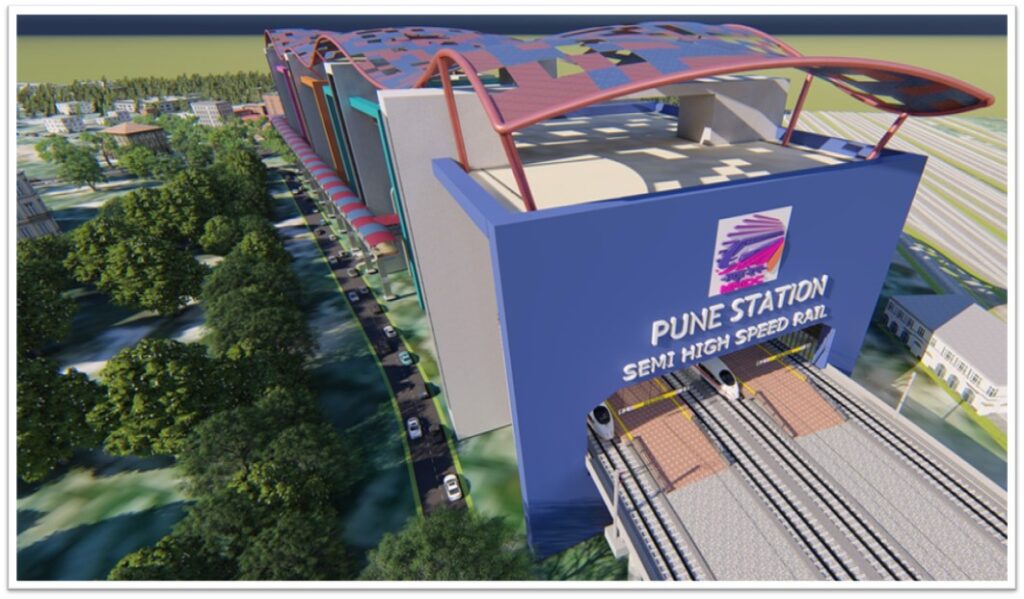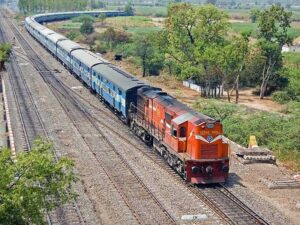Maharashtra Cabinet approves Greenfield Pune – Nashik Semi High-Speed Rail Line

Pune/Mumbai, 08 March, 2021- Railway is the backbone of economic development of any country in the world. Road and Rail transport facilities have expanded simultaneously in region and countries like Europe, Japan, South Korea, Russia and China. This has led to an unprecedented opportunity to achieve the sustainability and growth which is required for the 21st century. However, in our country Road infrastructural facilities have been developed extensively as compared to Railway Lines.
Need for developing New Railway Line
As per the Ministry of Road Transport and Highways (MoRTH), prior to 2014, the length of National Highways in the State of Maharashtra was 6,249 km. In 2018, the National Highway length has been increased to 17,749 km. Thus, a tremendous increase in construction of 11,500 km of National Highway roads was found in Maharashtra in just 4 years from 2014 to 2018. In comparison to that 229 km of new Rail Lines have been added in Maharashtra in last 10 years.
The following table illustrates the comparison of Roadways and Railways scenarios in India and Maharashtra:
Roadways and Railways scenario in India and Maharashtra
| Regions | Total Land Area (sq.km) | Total Road
length (km) |
Total Rail length (km) | Road length Per sq.km | Rail length Per sq.km |
| India | 32,00,000 | 50,00,000 | 67,368 | 1.56 | 0.021 |
| Maharashtra | 3,07,713 | 6,23,972 | 5,784 | 2.02 | 0.018 |
*The Total Road length is obtained from Basic Road Statistics of India 2016-17 report *The Total Rail Length is obtained from Indian Railway Civil Engineering Portal 2016 -17 report
This table shows, Maharashtra is having a higher density of Roadways while the Railway network is grossly inadequate. Hence, there is a need for developing new Railway Lines in Maharashtra to meet the massive transportation requirements. This need for developing new Railway Line was much appreciated and acknowledged by Uddhav Thackeray, Hon’ Chief Minister; Ajit Pawar Hon’ Deputy Chief
1
Minister; Adv. Anil Parab Hon’ Transport Minister; Satej D. Patil Hon’ Minister for State (Transport), Secretaries and various concerned Senior Authorities at the meeting held recently on 14th January 2021.
Pune – Nashik Semi High-Speed Railway Line
The much-awaited Pune-Nashik Semi-High speed Rail Line would bring down travel time between two cities from present 06 hours to 01 hour 45 mins boosting passenger and freight movements. Thus, it will facilitate the creation of Mumbai Pune-Nashik golden triangle as an emerging economic hub.
Earlier MRIDC had received “In Principal Approval” (IPA) from Ministry of Railways on 02.06.2020 and approval from Central Railway on 10.02.2020 for implementing Greenfield Semi – High Speed Broad Gauge Double Line between Pune and Nashik.
Rajesh Kumar Jaiswal, Managing Director, MahaRail who has authored a book “Construction and Maintenance of High-Speed Railway” and has good expertise on High-Speed Trains said – “This project will be a role model for development of new Railway Line networks in Maharashtra. This project is unique because it is the first
Broad-Gauge Semi-High Speed Rail Line in India and in the world. It is designed in such a way that goods train, conventional passenger train as well as High-Speed train can run on the same route.”
The entire cost of the project has been pegged at Rs 16,039 Crore (including taxes) on Debt: Equity of 60:40 basis; wherein the Government of Maharashtra and Ministry of Railway shall contribute equity of 20% each of the project cost. While remaining 60% will be raised from the Domestic Financial Institution. MahaRail has estimated to complete the project in 1200 days from the date of its financial closure.
Details of the proposed alignment:
| Sr. No. | Particular | Details |
| 1 | Total length of the Railway Line | 235 Km |
| 2 | Maximum Permissible Speed | 200 Km/Hr (with further possibility of increase up to 250 Km/Hr) |
| 3 | Proposed Major and Minor Stations | 24 Stations with 11 Crossing Stations, 11 Flag Stations & 2 Terminal Stations |
| 4 | Total number of Tunnels in the corridor | 18 numbers |
| 5 | Total Viaducts on the Semi High Speed Railway Line | 19 numbers |
Significant Features of this project:
- This Semi High-Speed Train will start from new proposed Pune Railway station and it will be going to Hadapsar on elevated deck, from Hadapsar to Nashik the train will run on the ground and will go up to Nashik Road Railway station.
2
- The Semi High Speed Trains will initially have 06 coaches designed to run at speed of 200 Km/Hr with future increment up to 250 Km/Hr on the Broad-Gauge line. The number of coaches will increase to 12 and then to 16.
- The proposed alignment is designed such that there will be no compromise on speed. It is the first low cost Semi-High-Speed corridor in the country with the provision of being synchronised with existing features of Indian Railway.
- Private Freight Terminals (PFTs) are planned at major stations like Chakan, Manchar, Narayangaon, Alephata and Sangamner. Also, loading and unloading facilities are planned at various stations.
- The proposed alignment will pass through the talukas of Haveli, Khed, Ambegaon and Junnar tehsils of Pune district, Sangamner tehsil of Ahmednagar district and Sinnar and Nashik tehsils of Nashik district.
- This Rail Line will certainly augment the revenues from the multi-fold industries like automobile hub, electronics, pharmaceuticals, sugar mills and other agricultural activities in and around the Project Influence Areas.
- The passengers of varied travel purposes such as tourism, educations, agriculture and as well as business and daily shuttles will have ample of facilities to connect with the rest of places through this corridor.
- All the intercity movements and transportation for both passengers and freight will flourish because of faster movement on Rail Line between Pune and Nashik.
- The project is envisaged to yield tangible as well as non-tangible savings due to the reduction in the number of vehicles being used for transportation by roads as well as certain socio-economic benefits such as employment generation, reduction in number of accidents and reduction in pollution due to the vehicular traffic.






